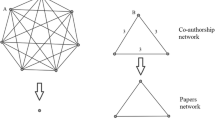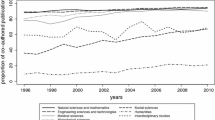Abstract
The paper introduces the use of blockmodeling in the micro-level study of the internal structure of co-authorship networks over time. Variations in scientific productivity and researcher or research group visibility were determined by observing authors’ role in the core-periphery structure and crossing this information with bibliometric data. Three techniques were applied to represent the structure of collaborative science: (1) the blockmodeling; (2) the Kamada-Kawai algorithm based on the similarities in co-authorships present in the documents analysed; (3) bibliometrics to determine output volume, impact and degree of collaboration from the bibliographic data drawn from publications. The goal was to determine the extent to which the use of these two complementary approaches, in conjunction with bibliometric data, provides greater insight into the structure and characteristics of a given field of scientific endeavour. The paper describes certain features of Pajek software and how it can be used to study research group composition, structure and dynamics. The approach combines bibliometric and social network analysis to explore scientific collaboration networks and monitor individual and group careers from new perspectives. Its application on a small-scale case study is intended as an example and can be used in other disciplines. It may be very useful for the appraisal of scientific developments.




Similar content being viewed by others
References
Barabási, A. L., & Albert, R. (1999). Emergence of scaling in random networks. Science, 286, 509–512.
Barabási, A. L., Jeong, H., Néda, Z., Ravasz, E., Schubert, A., & Vicsek, T. (2002). Evolution of the social network of scientific collaborations. Physica A, 311, 590–614.
Bartneck, C., & Hu, J. (2010). The fruits of collaboration in a multidisciplinary field. Scientometrics, 85, 41–52.
Batagelj, V., & Mrvar, A. (2003). Analysis and visualization of large networks. In M. Jünger & P. Mutzel (Eds.), Graph drawing software (pp. 77–103). Berlin: Springer.
Beaver, D. (2001). Reflections on scientific collaboration (and its study): past, present, and future. Scientometrics, 52, 365–377.
Beaver, D. (2004). Does collaborative research have greater epistemic authority? Scientometrics, 60(3), 399–408.
Borgatti, S. P., & Everett, M. G. (1999). Models of core/periphery structures. Soc Netw, 21, 375–395.
Borner, K., Dall’Asta, L., Ke, W., & Vespignani, A. (2005). Studying the emerging global brain: analyzing and visualizing the impact of co-authorship teams. Complexity, 10(4), 57–67.
Bozeman, B., & Lee, S. (2005). The impact of research collaboration on scientific productivity. Soc Stud Sci, 35(5), 673–702.
Braam, R., & van den Besselaar, P. (2010). Life cycles of research groups: the case of CWTS. Res Eval, 19(3), 173–184.
Braun, T., Glänzel, W., & Shubert, A. (2001). Publication and collaboration patterns of the authors of neuroscience journals. Scientometrics, 51, 499–510.
Caníbano, C., & Bozeman, B. (2009). Curriculum vitae method in science policy and research evaluation: the state-of-the-art. Res Eval, 18(2), 86–94.
Chinchilla-Rodríguez, Z., Benavent-Pérez, M., Miguel, S., Moya-Anegón, F. (2012). International collaboration in medical research in Latin America and the Caribbean (2003–2007). J Am Soc Inform Sci (in press).
Chinchilla-Rodríguez, Z., Vargas-Quesada, B., Hassan-Montero, Y., González-Molina, A., & Moya-Anegón, F. (2010). New approach to the visualization of international scientific collaboration. Inform Visualization, 9(4), 277–287.
Doreian, P., Batagelj, V., & Ferligoj, A. (2005). Generalized blockmodeling. Cambridge: Cambridge University Press.
Ferligoj, A., Doreian, P., & Batagelj, V. (2011). Positions and roles. In J. Scott & P. Carrington (Eds.), Sage handbook of social network analysis (pp. 434–446). Newbury Park: Sage Publications.
Ferligoj, A., & Kronegger, L. (2009). Clustering of attribute and/or relational data. Metodoloski zvezki (Adv Methodol Stat), 6(2), 135–153.
Hurd, J. M. (2000). The transformation of scientific communication: a model for 2020. J Am Soc Inform Sci, 51(14), 1279–1283.
Katz, J. S., & Martin, B. R. (1997). What is research collaboration? Res Policy, 26, 1–18.
Kronegger, L., Ferligoj, A., & Doreian, P. (2011). On the dynamics of national scientific systems. Qual Quant, 45(5), 989–1015.
Kronegger, L., Mali, F., Ferligoj, A., & Doreian, P. (2012). Collaboration structures in Slovenian scientific communities. Scientometrics, 90, 631–647.
Lancho-Barrantes, B. S., Guerrero-Bote, V. P., Chinchilla-Rodríguez, Z., & Moya-Anegón, F. (2012). Citation flows in the zones of influence of scientific collaborations. J Am Soc Inform Sci Technol, 63(3), 481–489.
Laudel, G. (2002). What do we measure by co-authorship? Res Eval, 11(1), 3–15.
Leydesdorff, L., & Vaughan, L. (2006). Co-occurrence matrices and their applications in information science: extending ACA to the web environment. J Am Soc Inform Sci Technol, 57(12), 1616–1628.
Mali, F., Kronegger, L., & Ferligoj, A. (2010). Co-authorship trends and collaboration patterns in the Slovenian sociological community. Corvinus J Sociol Soc Policy, 1(2), 29–50.
Melin, G. (2000). Pragmatism and self-organization: research collaboration at the individual level. Res Policy, 29(1), 31–40.
Miguel, S. (2009). Oportunidades y desafíos actuales de la investigación en Bibliotecología y Ciencia de la Información. El caso del Departamento de Bibliotecología de la Universidad Nacional de La Plata, Argentina. Información, Cultura y Sociedad, (21), 51–67. http://www.scielo.org.ar/pdf/ics/n21/n21a04.pdf.
Miguel, S., Chinchilla-Rodríguez, Z., González, C., Moya-Anegón, F. Analysis and visualization of the dynamics of research groups through a comparative input/output perspective. Information Research (in press).
Moed, H. F. (2008). UK research assessment exercises: informed judgments on research quality or quantity? Scientometrics, 74, 141–149.
Moody, J. (2004). The structure of a social science collaboration network: disciplinary cohesion from 1963 to 1999. Am Sociol Rev, 69(2), 213–238.
Newman, M. E. J. (2001). The structure of scientific collaboration networks. Proc Nat Acad Sci US, 98(2), 404–409.
Newman, M. E. J. (2004). Coauthorship networks and patterns of scientific collaboration. Proc Nat Acad Sci USA, 98 (Suppl. 2), 16, 404-409.
Newman, M. E. J. (2004b). Who is the best connected scientist? A study of scientific coauthorship networks. In E. Ben-Naim, H. Frauenfelder, & Z. Toroczkai (Eds.), Complex networks (pp. 337–370). Berlin: Springer.
Onofrio, M. G. (2009). The public CV database of Argentine researchers and the ‘CV-minimum’ Latin–American model of standardization of CV information for R&D evaluation and policy-making. Res Eval, 18(2), 95–103.
Perianes-Rodríguez, A., Chinchilla-Rodríguez, Z., Vargas-Quesada, B., Olmeda-Gómez, C., & Moya-Anegón, F. (2009). Synthetic hybrid indicators based on scientific collaboration to quantify and evaluate individual research results. J Informetr, 3(2), 91–101.
Persson, O., Glänzel, W., & Danell, R. (2004). Inflationary bibliometric values: the role of scientific collaboration and the need for relative indicators in evaluative studies. Scientometrics, 60(3), 421–432.
Price, D. (1963). Little science, big science. New York: Columbia University Press.
Price, D., & Beaver, D. (1966). Collaboration in an invisible college. Am Psychol, 21, 1011–1018.
Price, D. J. S., Gürsey, S. (1976). Studies in scientometrics. Part 1. Transience and continuance in scientific authorship. International Forum on Information and Documentation No. 1, pp. 17–24.
Shaw, D., & Vaughan, L. (2008). Publication and citation patterns among LIS faculty: profiling a “typical professor”. Libr Inform Sci Res, 30(1), 47–55.
Sonnenwald, D. (2007). Scientific collaborations. Annu Rev Inform Sci Technol, 41, 643–681.
Wagner, C. S., & Leydesdorff, L. (2005). Network structure, self-organization, and the growth of international collaboration in science. Res Policy, 34, 1608–1618.
Watts, D. J., & Strogatz, S. H. (1998). Collective dynamics of ‘small-world’ networks. Nature, 393, 440–442.
White, H. D. (2003). Author cocitation analysis and pearson’s r. J Am Soc Inform Sci Technol, 54(13), 1250–1259.
Acknowledgments
The authors wish to thank Claudia González for compiling the data, Vladimir Batagelj for his technical support and suggestions, anonymous referees for comments that improved the present analysis and Margaret Clark for editing the English text. This research was partially funded by the Spanish National Research Council under the project entitled “Generación de herramientas cienciométricas para el análisis de la colaboración científica” (Proyecto Intramural CSIC 200810I210).
Author information
Authors and Affiliations
Corresponding author
Rights and permissions
About this article
Cite this article
Chinchilla-Rodríguez, Z., Ferligoj, A., Miguel, S. et al. Blockmodeling of co-authorship networks in library and information science in Argentina: a case study. Scientometrics 93, 699–717 (2012). https://doi.org/10.1007/s11192-012-0794-6
Received:
Published:
Issue Date:
DOI: https://doi.org/10.1007/s11192-012-0794-6




